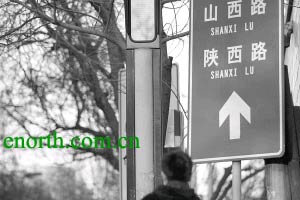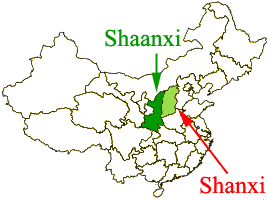
A sign in Tianjin, China, points toward two roads, which, although they have different names, are both labeled “SHANXI LU”.
The two roads are named after adjacent Chinese provinces: Shānxī (山西), whose largest city is Taiyuan, and Shǎnxī ( 陝西 / 陕西), which contains Xi’an. So “Shanxi” would appear to be appropriate for both if tone marks are omitted, which is, obviously, sometimes definitely a bad idea.
But because these names are both often used and leaving off the tone mark in their romanized forms could lead to confusion, the PRC authorities long ago decided to alter the romanization of Shǎnxī by borrowing a trick from Y.R. Chao’s tonal spelling system; in this exceptional case, a doubled a is used to represent the third-tone a in Shǎnxī, rendering the province’s name as “Shaanxi”. (This is not intended to change the pronunciation in the slightest, which is still Shǎnxī in modern standard Mandarin. Pronouncing “Shaanxi” with a drawn-out a — Shaaaaaaaaaaaaaaaaaaanxi — is incorrect.)
In Gwoyeu Romatzyh, a first-tone a is spelled simply a, so “Shanxi” could be said to use this as well. And in the old postal system romanizations that predated Hanyu Pinyin for the names, the provinces were “Shensi” and “Shansi”.
So the signs in the photo should read “SHANXI LU” for 山西路 (Shānxī Lù) and “SHAANXI LU” for 陕西路 (Shǎnxī Lù). The local authorities, however, say they can’t do anything to change this:
Tiānjīn Shì Dìmíng Bàngōngshì de gōngzuò rényuán biǎoshì, ànzhào “Tiānjīn Shì dìmíng guǎnlǐ tiáolì” de guīdìng, dìmíng de Hànyǔ Pīnyīn Fāng’àn yào yǐ Hànyǔ Pīnyīn hé pīnxiě guīzé wéi biāozhǔn, bùdé shǐyòng wàiwén pīnxiě. Tóngyàng, Tiānjīn Shì yǔyán wénzì péixùn cèshì zhōngxīn de gōngzuò rényuán yě biǎoshì, xiàng Shānxī Lù hé Shǎnxī Lù de Hànyǔ Pīnyīn pīnxiě fāngshì quèshí wúfǎ gēnggǎi.
(天津市地名办的工作人员表示,按照《天津市地名管理条例》的规定,地名的汉语拼音方案要以汉语拼音和拼写规则为标准,不得使用外文拼写。同样,天津市语言文字培训测试中心的工作人员也表示,像山西路和陕西路的汉语拼音拼写方式确实无法更改。)
This is absurd. “Shaanxi” is not a “foreign-language spelling” (wàiwén pīnxiě). The name is in Mandarin, China’s official language, and Shaanxi is China’s own spelling for this, as should be no mystery to anyone who has access to a map of China published in the last few decades. Also, Hanyu Pinyin’s rules — which are based on words, not syllables, and most definitely not on Chinese characters taken in isolation — take this exception into account. Using “Shaanxi” to refer to 陕西 Province is perfectly acceptable in Hanyu Pinyin.

source: ‘SHANXI LU’: Nín cāi shì nǎ tiáo lù? (SHANXI LU 您猜是哪条路?), Měirì xīn bào (每日新报), December 29, 2006

Greetings –
I was baffled (and midly annoyed) at the lack of Pinyin on Chinese street signs went I took a trip to China last spring. I never encountered the Shanxi/Shaanxi problem specifically, but I it trouble me that I could not look a a sign and immediately know the correct pronounciation from the romanization alone.
I’ve browsed through your https://pinyin.info/news/2007/shanxi-shaanxi/ article, yet still don’t fully understand why official street/highway signs do no Romanize spellings via the official Pinyin) method. The use of the double makes sense but for the existence of the ? symbol to accomplish the same thing AND conform to Pinyin.
Babelfish (I’m learning, but am not remotely effective, in Chinese) translated the explanation to me as follows:
(The Tianjin geographic name manages the staff indicated, according to “Tianjin Geographic name Act of administration” the stipulation, the geographic name scheme for the Chinese phonetic alphabet must take Chinese Pinyin and the spelling rule as a standard, does not have to use the foreign language to spell. Similarly, the Tianjin language and writing training test center staff also indicated that, the Xiangshan west road and the Shaanxi west road Chinese Pinyin spelling way truly is unable to change. )
The issue still does not make sense to me – the statement seems to confirm that Pinyin is the standard, yet by the absence of tonal markings on the Shanxi sign (and by my experience last spring), it is evident that Pinyin is not strictly in use.
What is the real reasoning behind the lack of Pinyin on official signage? Is there any effort to actually convert existing signage to real Pinyin (it seems unlikely)?
Thanks,
Galen Moore
Parker, CO
Galen, you’ve brought up a very important point: China screws up its own romanization system much more often than it gets it right. This is indeed a strange state of affairs.
Moreover, as you guessed, there is no comprehensive effort to convert existing signage to full Pinyin (with tone marks, proper word parsing, etc.). Indeed, to some degree over the past few years the main trend in official signage in China has been away from Pinyin and toward a mixture of Pinyin and English. And a particularly heinous offense against Pinyin usage has been InTerCaPiTaLiZaTion, which has been enjoying increasing popularity, even in China. (Using all capital letters, bad as it may be, at least eliminates the possibility of InTerCaPiTaLiZaTion.)
There are a number of factors behind China’s (mis)use of Pinyin. First, China teaches Pinyin poorly, generally as a character-annotation method rather than as the full writing system that it is. And schools usually drop it once students move further into characters. In addition, there’s almost no material widely available in China that displays Pinyin the way it is meant to be seen.
There is no political will to change this. If anything, there is suppression of Pinyin — both, on the one hand, from those who see it as something for children or ignorant people and thus not to be taken seriously, and on the other from those who see its success as a threat to Chinese characters.
Regarding tone marks, they *generally* aren’t necessary for native speakers of Mandarin. Whether it’s a good idea to omit them, however, is another matter.
http://jidanni.org/geo/house_numbering/post_office_zipcode_cdrom.txt has close calls
mysql> SELECT DISTINCT HROAD,ROAD FROM rall1 WHERE HROAD REGEXP ‘Shanxi .\. 1st St\.’;
Shanxi N. 1st St. ?????
Shanxi S. 1st St. ?????
Shanxi E. 1st St. ?????
I am surprised that two different provinces in China are rendered as SHANXI in the naming of these streets. Did the enquirer also referred to the Chinese Maps published in Pinyin? This particular case is a good example of the Chinese incompetant handling of geographical names in Pinyin. I don’t believe Japanese make similar mistakes with their Romazi names.
Come to think about it, even under the British rule, Hong Kong was usually spelled as two words but Kowloon never splitted up into Kow Loon. Yet the full name of HSBC was Hongkong and Shanghai Bank with the Hongkong spelled as one word.
If I remember correctly, when UN adopted Hanyu Pinyin as the standard for rendering Chinese geographical names into Romanized language in the Seventies, the tone marks were left out the Roman languages. At that time, the language experts in the Committee on Geographical Names considered Pinyin system as a linguistically sound system. Looking back from the present, I think it was a good choice as we all know that without learning a language it is hard to expect one can pronounce those names correctly and English is a good example for poor phonetic representation. We should treat all geographical names as labels, the pronunciation of them should be learned via phonetic annotations while learning the language. It would be too much for a tourist to know how to pronounce the names correctly. However, it is ironical that when the Chinese translation of foreign names phonetically while the alphabetic western languages emphasize standardized spellings ( shutongwen ???). This may partly due to the need of computer search and partly due to the recognition that if one goes for correct pronunciations one has to give up standardized spellings. This really is a ‘fish and bear paw'(????) situation. What do you think how a Spanish speaker would pronounce Beijing????- Apollo Wu
All I know is all the big name social networking sites I sign up on in my desperate struggle to get a date all only give me choices to choose between T’ai Ch’ung Hsien and T’ai Ch’ung Shih :-(
zhèishi Zhongguo Guojia Yüyan Wenzyi Gonzwo Weiyuan Huì de chirvu.
Ninmen bié z?nshi b? zhèixe dondon tiee chulai ràng lau xianshengmen diue rén.
Comments in Pinyin are of course welcome. But please try to follow standard spelling and orthography.